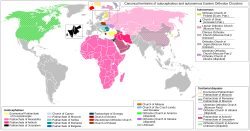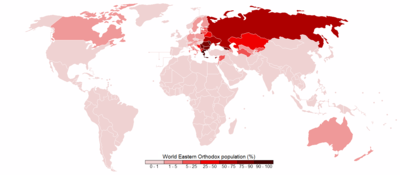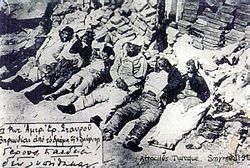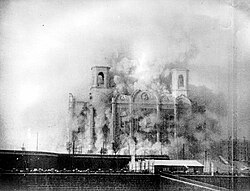Timeline of the History of the main autocephalous Eastern Orthodox Churches, E. Orthodox point of view (2022)
By "main", I (User:Veverve) mean a) churches wich were recognised as autocephalous by at least one other church - other church which is recognised as autocephalous by the other churches; b) churches which became part of churches wich were recognised as autocephalous by at least one other church - other church which is recognised as autocephalous by the other churches; c) the en:Orthodox Church of Ukraine (its case is complicated, see en:2018 Moscow–Constantinople schism). The UOC-KP after its departure from the OCU was included, because its departure was really soon after its merge, and because it was never clear if it was really part of the Orthodox Church of Ukraine (see en:Conflict between Filaret and Epiphanius).
The timeline starts at the council of Chalcedon, as it appears the Church of Jerusalem was not autocephalous before this council, and the bishop of en:Ælia Capitolina (Jerusalem) was under the Metropolis of Caesarea; it is unclear under whom the Metropolis of Caesarea was under.
For the sake of brievity and clarity, the timeline has an E. Orthodox bias: all Churches are shown as being E. Orthodox since the Council of Chalcedon, with the Church of Rome starting being Roman Catholic in 1054.
The date of autocephaly of the Georgian Orthodox Church may vary wildly depending on the source you look at. I used the latest date which is given in The Encyclopedia of Eastern Orthodox Christianity (art. 'Georgia, Patriarchal Orthodox Church of'). John Wiley & Sons. 2011. See this section of the Wikipedia article. The Georgian Orthodox Church's juridictional origin is almost all the time considered as being the Church of Antioch, but once, at the fr:Exarchat de Géorgie, I found the Church of Constantinople as the mother Church of Georgia.
The en:Oriental Orthodox Churches are not shown, because their presence is outside the scope of this timeline.
- Dílo smíte:
- šířit – kopírovat, distribuovat a sdělovat veřejnosti
- upravovat – pozměňovat, doplňovat, využívat celé nebo částečně v jiných dílech
- Za těchto podmínek:
- uveďte autora – Máte povinnost uvést autorství, poskytnout odkaz na licenci a uvést, pokud jste provedli změny. Toho můžete docílit jakýmkoli rozumným způsobem, avšak ne způsobem naznačujícím, že by poskytovatel licence schvaloval nebo podporoval vás nebo vaše užití díla.
- zachovejte licenci – Pokud tento materiál jakkoliv upravíte, přepracujete nebo použijete ve svém díle, musíte své příspěvky šířit pod stejnou nebo slučitelnou licencí jako originál.
Vlastní dílo
Tento soubor byl odvozen z: Timeline of the main schisms from the Russian Orthodox Church (1589 to 2021).svg
Information from:
- - Bulgarian Orthodox Church/Archbishopric of Ohrid: en:Bulgarian Orthodox Church; "The autocephalous Byzantine ecclesiastical province of Bulgaria/Ohrid. How independent were its archbishops?", Günter Prinzing; "The only émigré from the east whom the sources mention is the patriarch Damian who fled from Preslav when Tzimiskes conquered that city and abolished his office. Samuel shortly thereafter made Damian patriarch of a new patriarchate which Samuel established in Ohrid." - J. Fine, The Early Medieval Balkans: A Critical Survey from the Sixth to the Late Twelfth Century, p. 191-2 — "Romanos survived and according to Yahya ibn Sa‘td, the Christian Arabic historian who reports the most likely version of events, he was crowned emperor, presumably by the patriarch of Bulgaria (now re-established in the west)." - Mark Whittow, The Making of Byzantium (600–1025), p. 297. — en:John I Tzimiskes took Preslav in 971 according to en:Byzantine conquest of Bulgaria. I have put "970s" for the departure of the Patriarch from Preslav to Ohrid, as I had no precise date.
- - Archbishopric and Patriarchate of Tarnovo: en:Tarnovo Patriarchate
- - Bulgarian Exarchate: en:Bulgarian Exarchate / bg:Българска екзархия ; https://bnr.bg/en/post/101234490/150-years-since-establishment-of-bulgarian-exarchate ; https://www.britannica.com/topic/Bulgarian-Orthodox-Church
- - Bulgarian Orthodox Church – Alternative synod: en:Bulgarian Orthodox Church – Alternative synod (the Russian and Bulgarian versions of the article say the schism ended in 2012, the English one says 2015)
- - Georgian Orthodox Church: en:Georgian Orthodox Church , "Key aspects of Georgian Orthodox Church’s autocephaly", Zurab Katyteladze, fr:Exarchat de Géorgie
- - Serbian Patriarchate of Peć/Metropolitanate of Karlovci/Patriarchate of Karlovci/Metropolitanate of Zeta/Metropolitanate of Montenegro/Serbian Orthodox Church: en:Serbian Patriarchate of Peć, en:Metropolitanate of Karlovci, en:Patriarchate of Karlovci, en:Prince-Bishopric of Montenegro, en:Metropolitanate of Montenegro and the Littoral, en:Metropolitanate of Belgrade
- - Orthodox Church of Ukraine: en:Unification council of the Eastern Orthodox churches of Ukraine, en:Orthodox Church of Ukraine
- - 5th century:
- ■ Church of Cyprus: "The Claim of Antioch to Ecclesiastical Jurisdiction over Cyprus", Glanville Downey; there is doubt that Cyprus was ever part of the Church of Antioch
- ■ Church of Jerusalem: en:Juvenal of Jerusalem
- - 15th century:
- • Metropolis of Kyiv and all Rus'/Moscow Patriarchate from the Ecumenical Patriarchate: en:15th–16th century Moscow–Constantinople schism: the Metropolis of Kiev and all Rus' became the Moscow Patriarchate. Please read the article for more details.
- - 19th century:
- ■ Church of Greece from the Ecumenical Patriarchate: en:Tomos dated June 29, 1850, https://www.britannica.com/topic/Church-of-Greece: autocephaly unilateraly declared in 1830, Church of Greece recognised in 1850
- • Romanian Orthodox Church from the Ecumenical Patriarchate: en:Romanian Orthodox Church: autocephaly unilateraly declared in 1865, recognition in 1885.
- - 20th century:
- ■ Orthodox Church of Albania from the Ecumenical Patriarchate: en:Orthodox Church of Albania, en:Orthodox Congress (Albania): autocephaly unilateraly declared in 1922, recognition in 1937.
- - Other ressources: Demetrius Kiminas, The Ecumenical Patriarchate; en:Synod of Constantinople (1484)
- Requested by and knowledge from Veverve
Relevantní obrázky
Relevantní články
Organizace pravoslavných církvíPravoslavné církve tvoří společenství samosprávných (pravoslavných) místních církví, z nichž každá je autokefální, je tedy řízená vlastním nejvyšším představitelem – prvním z místních biskupů, který je nositelem titulu patriarcha případně metropolita či arcibiskup. .. pokračovat ve čtení
Autokefální církevAutokefální církev je společenství křesťanů, které je organizačně a právně nezávislé, nepodléhá tedy žádné vnější autoritě. .. pokračovat ve čtení
Pravoslavná církevPravoslavná církev, oficiálně pravoslavná katolická církev, je druhou největší křesťanskou církví s přibližně 220 miliony pokřtěných členů. Funguje jako společenství autokefálních církví, z nichž každá je řízena svými biskupy prostřednictvím místních synodů. Církev nemá ústřední doktrinální nebo vládní autoritu analogickou hlavě katolické církve – papeži, ačkoli ekumenický konstantinopolský patriarcha je jimi uznáván jako primus inter pares. Jako jedna z nejstarších dochovaných náboženských institucí na světě hrála pravoslavná církev významnou roli v dějinách a kultuře západní Asie, Kavkazu a východní a jihovýchodní Evropy. .. pokračovat ve čtení










































